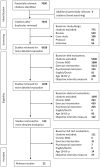The Influence of Exercise Intensity on Psychosocial Outcomes in Musculoskeletal Disorders: A Systematic Review
- PMID: 35243924
- PMCID: PMC9631039
- DOI: 10.1177/19417381221075354
The Influence of Exercise Intensity on Psychosocial Outcomes in Musculoskeletal Disorders: A Systematic Review
Abstract
Context: Psychosocial parameters play an important role in the onset and persistence of chronic musculoskeletal disorders (CMSDs). Exercise therapy is a valuable therapeutic modality as part of CMSD rehabilitation. Hereby, exercise intensity is an important factor regarding changes in pain and disability in multiple CMSDs. However, the impact of exercise intensity on psychosocial outcomes remains poorly explored.
Objective: To identify the effects of different modes of exercise intensity on psychosocial outcomes in persons with CMSDs.
Data sources: A systematic search was conducted up to November 2020 using the following databases: PubMed/MEDline, PEDro, Cochrane Library, and Web of Science.
Study selection: Studies reporting exercise therapy in CMSDs with a predefined display of exercise intensity and an evaluation of at least 1 psychosocial outcome were included.
Study design: Systematic review.
Level of evidence: Level 2a.
Data extraction: Data regarding demographics, exercise intensity, and psychosocial outcomes were included in a descriptive analysis. Methodological quality was assessed using the PEDro scale and Critical Appraisal Skills Programme (CASP) checklist.
Results: A total of 22 studies, involving 985 participants (with fibromyalgia, chronic low back pain, knee osteoarthritis, psoriatic arthritis, and axial spondyloarthritis) were included (mean PEDro score = 5.77/10). The most common psychosocial outcomes were quality of life (QoL) (n = 15), depression (n = 10), and anxiety (n = 9). QoL improved at any exercise intensity in persons with fibromyalgia. However, persons with fibromyalgia benefit more from exercising at low to moderate intensity regarding anxiety and depression. In contrast, persons with chronic low back pain benefit more from exercising at a higher intensity regarding QoL, anxiety, and depression. Other CMSDs only showed limited or conflicting results regarding the value of certain exercise intensities.
Conclusion: Psychosocial outcomes are influenced by the intensity of exercise therapy in fibromyalgia and chronic low back pain, but effects differ across other CMSDs. Future research is necessary to determine the exercise intensity that yields optimal exercise therapy outcomes in specific CMSDs.
Keywords: chronic musculoskeletal disorder; exercise therapy; intensity; psychosocial parameters.
Conflict of interest statement
The authors report no potential conflicts of interest in the development and publication of this article.
Figures
References
-
- Ahlstrand I, Vaz S, Falkmer T, Thyberg I, Björk M. Self-efficacy and pain acceptance as mediators of the relationship between pain and performance of valued life activities in women and men with rheumatoid arthritis. Clin Rehabil. 2017;31:824-834. - PubMed
-
- Andrade A, Dominski FH, Sieczkowska SM. What we already know about the effects of exercise in patients with fibromyalgia: an umbrella review. Semin Arthritis Rheum. 2020;50:1465-1480. - PubMed
-
- Ang DC, Bair MJ, Damush TM, Wu J, Tu W, Kroenke K. Predictors of pain outcomes in patients with chronic musculoskeletal pain co-morbid with depression: results from a randomized controlled trial. Pain Med. 2010;11:482-491. - PubMed
-
- Armijo-Olivo S, Fuentes J, da Costa BR, Saltaji H, Ha C, Cummings GG. Blinding in physical therapy trials and its association with treatment effects: a meta-epidemiological study. Am J Phys Med Rehabil. 2017;96:34-44. - PubMed
-
- Bailey KM, Carleton RN, Vlaeyen JW, Asmundson GJ. Treatments addressing pain-related fear and anxiety in patients with chronic musculoskeletal pain: a preliminary review. Cogn Behav Ther. 2010;39:46-63. - PubMed
Publication types
MeSH terms
LinkOut - more resources
Full Text Sources
Medical
Research Materials


